Importance of Creativity and Innovation in Human Capital Development
VerifiedAdded on 2023/06/07
|9
|2227
|411
AI Summary
Creativity and innovation are vital aspects of human capital. From innovation and creativity rises technological development which is essential in the growth and development of an economy. This article discusses the importance of creativity and innovation in human capital development, the role of technology in economic development, and the benefits of creativity and innovation in keeping businesses competitive and creating jobs. The article also focuses on Brazil as a country of focus and the barriers it faces in boosting creativity and innovation.
Contribute Materials
Your contribution can guide someone’s learning journey. Share your
documents today.
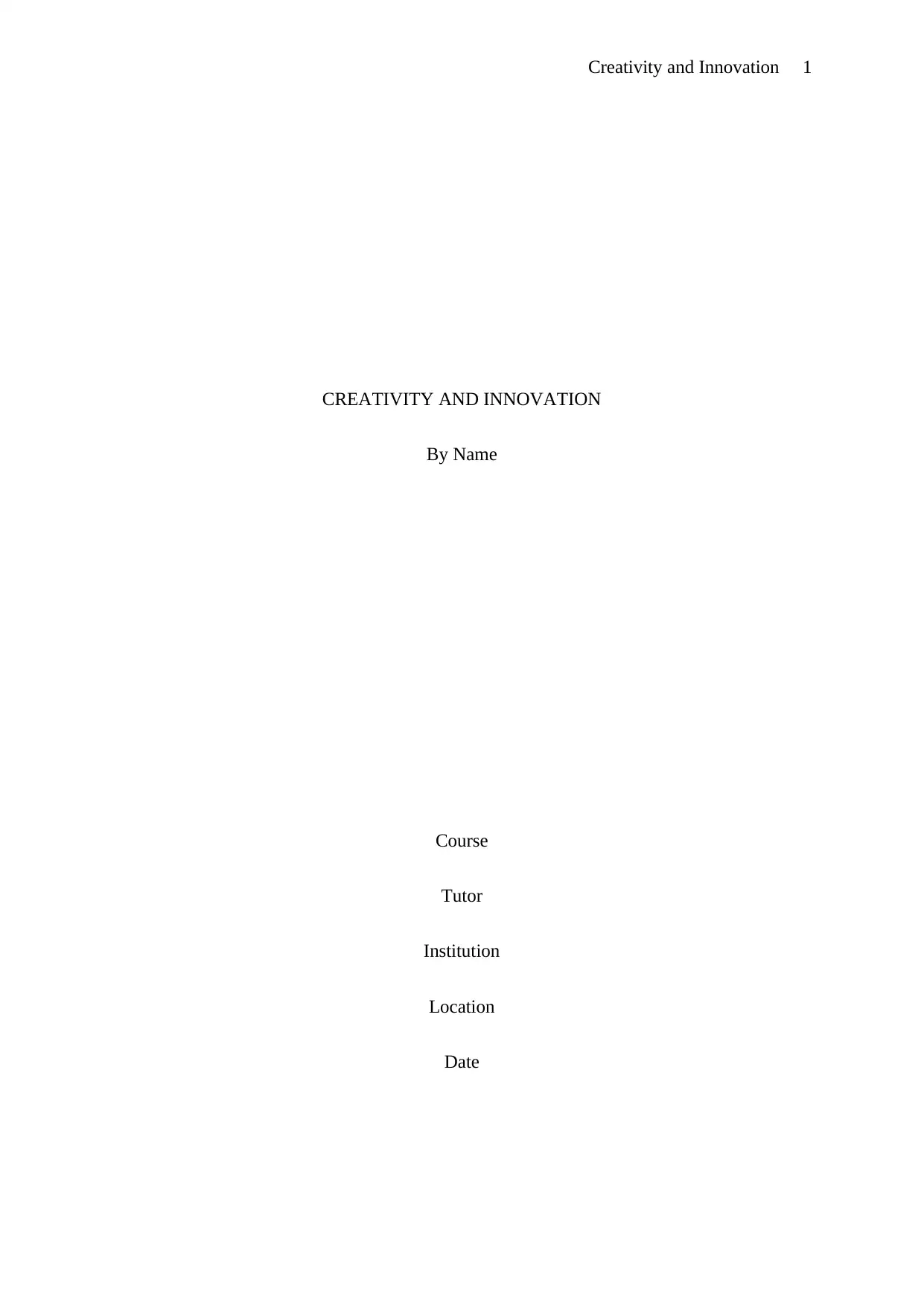
Creativity and Innovation 1
CREATIVITY AND INNOVATION
By Name
Course
Tutor
Institution
Location
Date
CREATIVITY AND INNOVATION
By Name
Course
Tutor
Institution
Location
Date
Secure Best Marks with AI Grader
Need help grading? Try our AI Grader for instant feedback on your assignments.
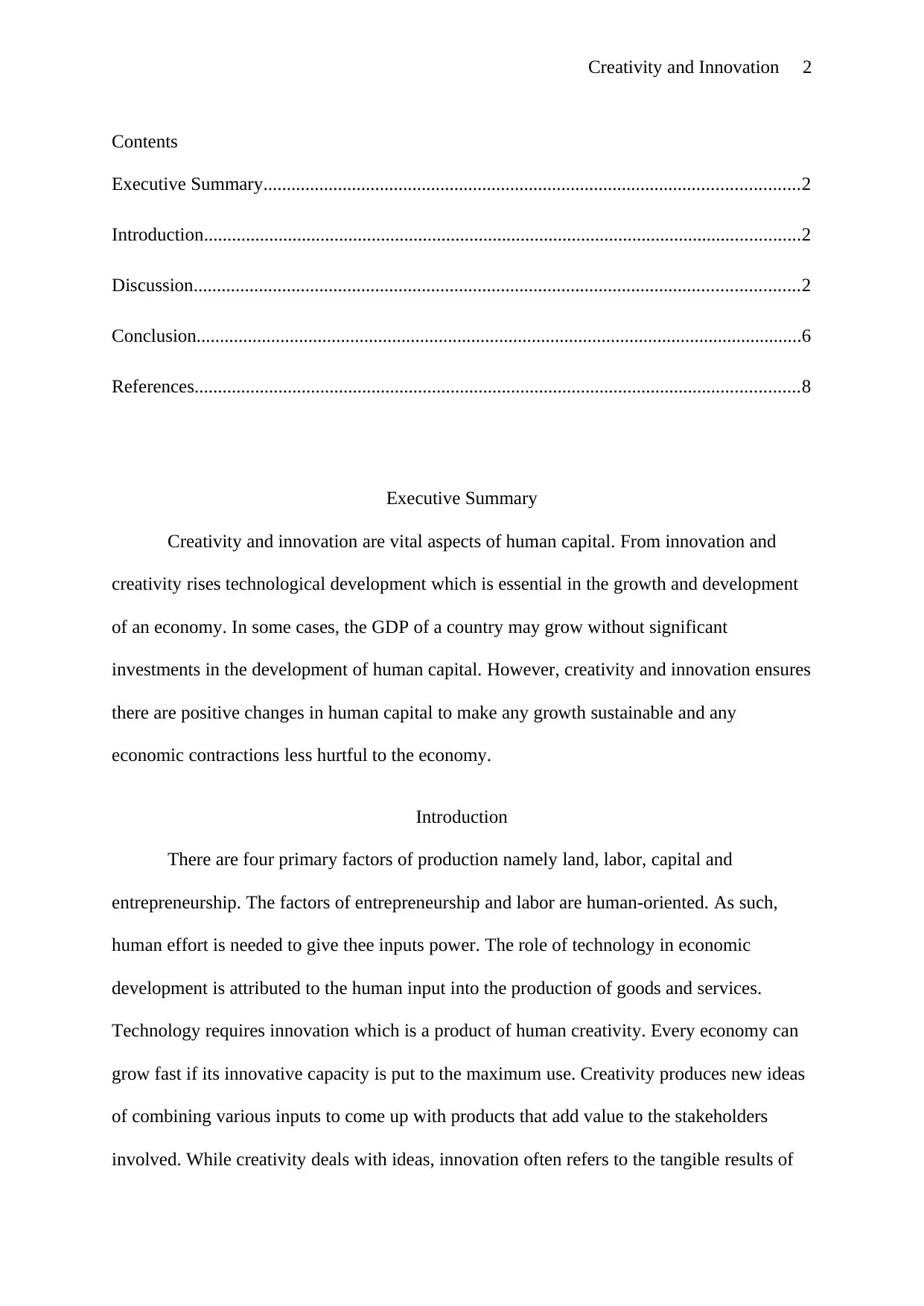
Creativity and Innovation 2
Contents
Executive Summary...................................................................................................................2
Introduction................................................................................................................................2
Discussion..................................................................................................................................2
Conclusion..................................................................................................................................6
References..................................................................................................................................8
Executive Summary
Creativity and innovation are vital aspects of human capital. From innovation and
creativity rises technological development which is essential in the growth and development
of an economy. In some cases, the GDP of a country may grow without significant
investments in the development of human capital. However, creativity and innovation ensures
there are positive changes in human capital to make any growth sustainable and any
economic contractions less hurtful to the economy.
Introduction
There are four primary factors of production namely land, labor, capital and
entrepreneurship. The factors of entrepreneurship and labor are human-oriented. As such,
human effort is needed to give thee inputs power. The role of technology in economic
development is attributed to the human input into the production of goods and services.
Technology requires innovation which is a product of human creativity. Every economy can
grow fast if its innovative capacity is put to the maximum use. Creativity produces new ideas
of combining various inputs to come up with products that add value to the stakeholders
involved. While creativity deals with ideas, innovation often refers to the tangible results of
Contents
Executive Summary...................................................................................................................2
Introduction................................................................................................................................2
Discussion..................................................................................................................................2
Conclusion..................................................................................................................................6
References..................................................................................................................................8
Executive Summary
Creativity and innovation are vital aspects of human capital. From innovation and
creativity rises technological development which is essential in the growth and development
of an economy. In some cases, the GDP of a country may grow without significant
investments in the development of human capital. However, creativity and innovation ensures
there are positive changes in human capital to make any growth sustainable and any
economic contractions less hurtful to the economy.
Introduction
There are four primary factors of production namely land, labor, capital and
entrepreneurship. The factors of entrepreneurship and labor are human-oriented. As such,
human effort is needed to give thee inputs power. The role of technology in economic
development is attributed to the human input into the production of goods and services.
Technology requires innovation which is a product of human creativity. Every economy can
grow fast if its innovative capacity is put to the maximum use. Creativity produces new ideas
of combining various inputs to come up with products that add value to the stakeholders
involved. While creativity deals with ideas, innovation often refers to the tangible results of
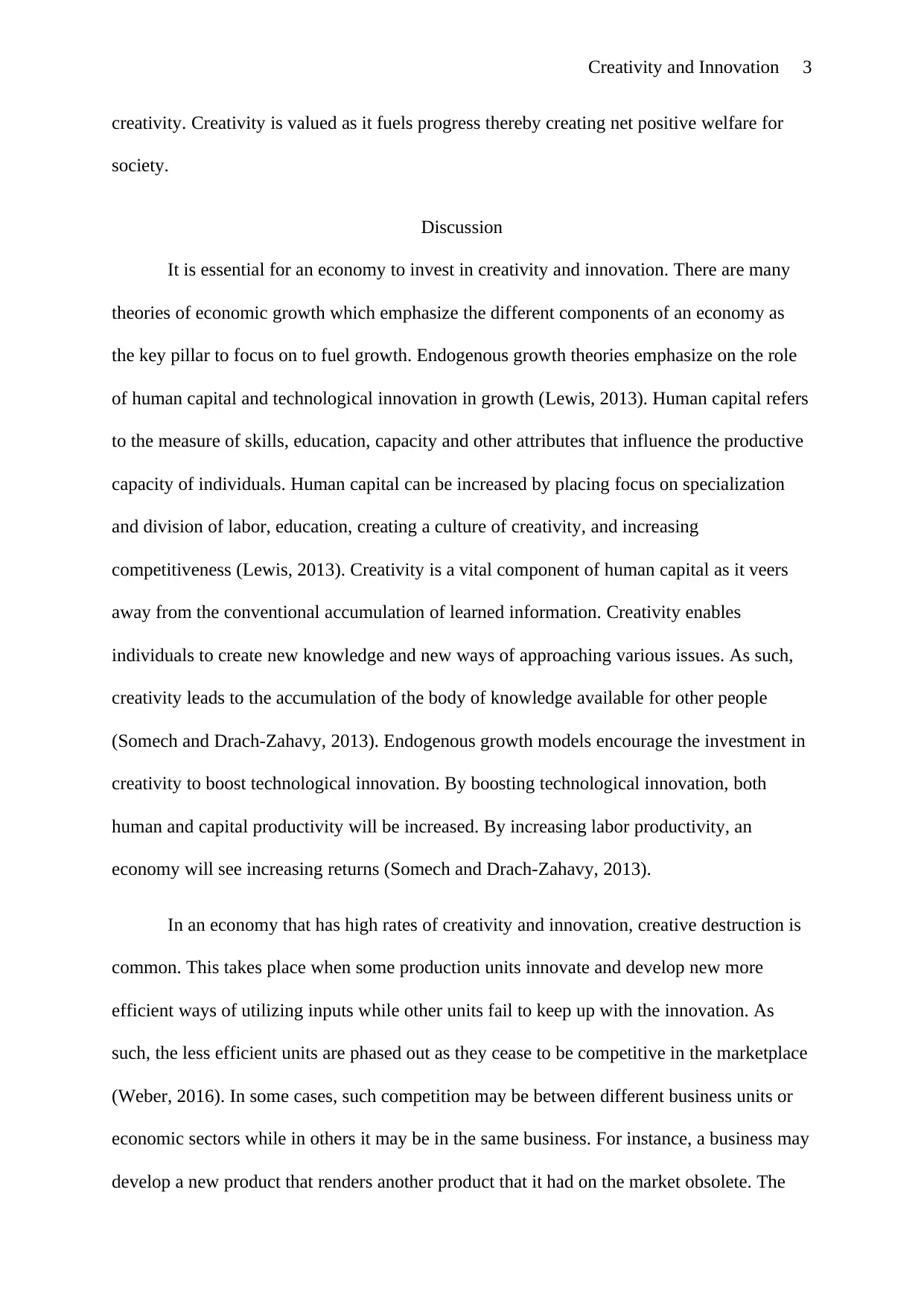
Creativity and Innovation 3
creativity. Creativity is valued as it fuels progress thereby creating net positive welfare for
society.
Discussion
It is essential for an economy to invest in creativity and innovation. There are many
theories of economic growth which emphasize the different components of an economy as
the key pillar to focus on to fuel growth. Endogenous growth theories emphasize on the role
of human capital and technological innovation in growth (Lewis, 2013). Human capital refers
to the measure of skills, education, capacity and other attributes that influence the productive
capacity of individuals. Human capital can be increased by placing focus on specialization
and division of labor, education, creating a culture of creativity, and increasing
competitiveness (Lewis, 2013). Creativity is a vital component of human capital as it veers
away from the conventional accumulation of learned information. Creativity enables
individuals to create new knowledge and new ways of approaching various issues. As such,
creativity leads to the accumulation of the body of knowledge available for other people
(Somech and Drach-Zahavy, 2013). Endogenous growth models encourage the investment in
creativity to boost technological innovation. By boosting technological innovation, both
human and capital productivity will be increased. By increasing labor productivity, an
economy will see increasing returns (Somech and Drach-Zahavy, 2013).
In an economy that has high rates of creativity and innovation, creative destruction is
common. This takes place when some production units innovate and develop new more
efficient ways of utilizing inputs while other units fail to keep up with the innovation. As
such, the less efficient units are phased out as they cease to be competitive in the marketplace
(Weber, 2016). In some cases, such competition may be between different business units or
economic sectors while in others it may be in the same business. For instance, a business may
develop a new product that renders another product that it had on the market obsolete. The
creativity. Creativity is valued as it fuels progress thereby creating net positive welfare for
society.
Discussion
It is essential for an economy to invest in creativity and innovation. There are many
theories of economic growth which emphasize the different components of an economy as
the key pillar to focus on to fuel growth. Endogenous growth theories emphasize on the role
of human capital and technological innovation in growth (Lewis, 2013). Human capital refers
to the measure of skills, education, capacity and other attributes that influence the productive
capacity of individuals. Human capital can be increased by placing focus on specialization
and division of labor, education, creating a culture of creativity, and increasing
competitiveness (Lewis, 2013). Creativity is a vital component of human capital as it veers
away from the conventional accumulation of learned information. Creativity enables
individuals to create new knowledge and new ways of approaching various issues. As such,
creativity leads to the accumulation of the body of knowledge available for other people
(Somech and Drach-Zahavy, 2013). Endogenous growth models encourage the investment in
creativity to boost technological innovation. By boosting technological innovation, both
human and capital productivity will be increased. By increasing labor productivity, an
economy will see increasing returns (Somech and Drach-Zahavy, 2013).
In an economy that has high rates of creativity and innovation, creative destruction is
common. This takes place when some production units innovate and develop new more
efficient ways of utilizing inputs while other units fail to keep up with the innovation. As
such, the less efficient units are phased out as they cease to be competitive in the marketplace
(Weber, 2016). In some cases, such competition may be between different business units or
economic sectors while in others it may be in the same business. For instance, a business may
develop a new product that renders another product that it had on the market obsolete. The
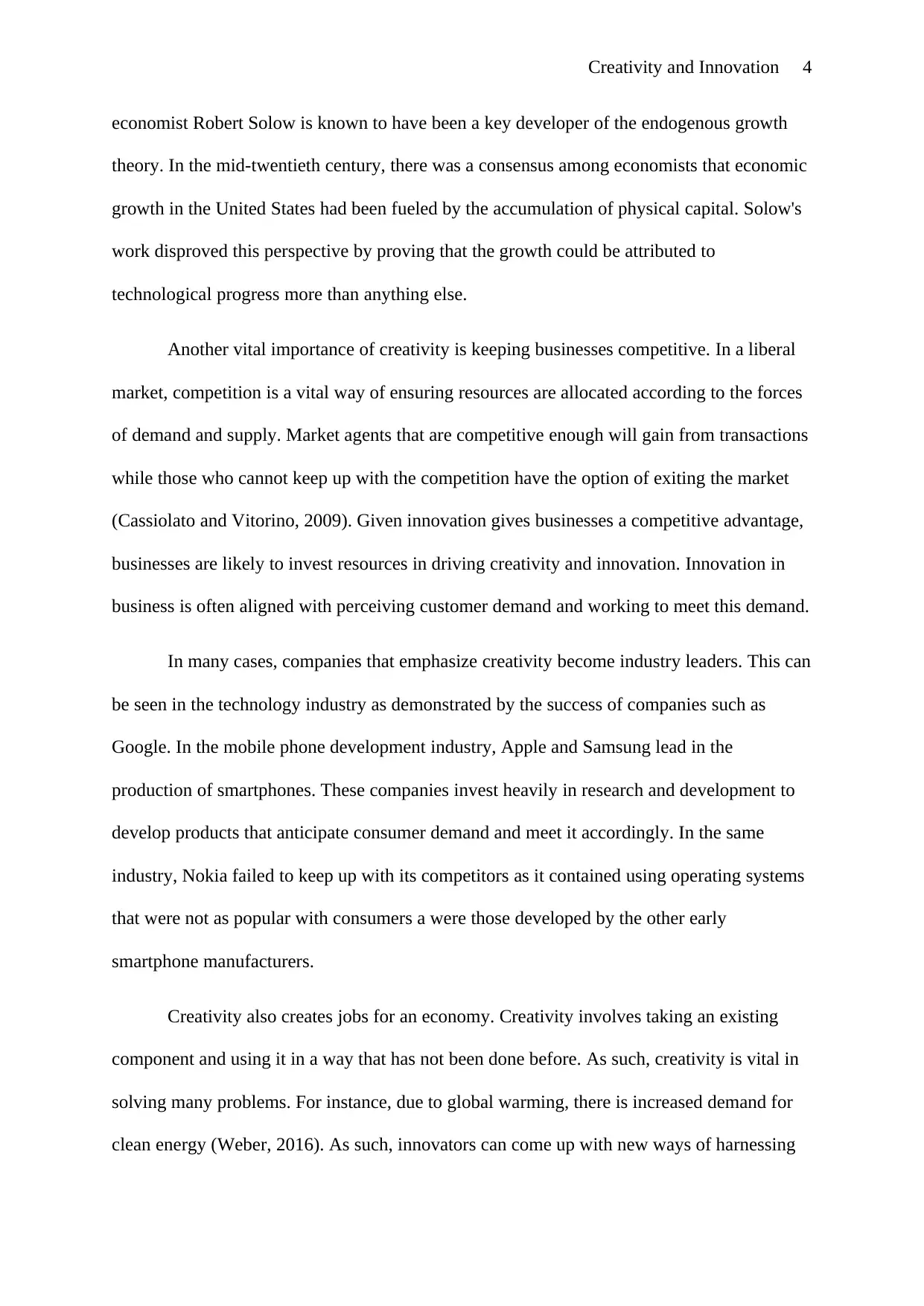
Creativity and Innovation 4
economist Robert Solow is known to have been a key developer of the endogenous growth
theory. In the mid-twentieth century, there was a consensus among economists that economic
growth in the United States had been fueled by the accumulation of physical capital. Solow's
work disproved this perspective by proving that the growth could be attributed to
technological progress more than anything else.
Another vital importance of creativity is keeping businesses competitive. In a liberal
market, competition is a vital way of ensuring resources are allocated according to the forces
of demand and supply. Market agents that are competitive enough will gain from transactions
while those who cannot keep up with the competition have the option of exiting the market
(Cassiolato and Vitorino, 2009). Given innovation gives businesses a competitive advantage,
businesses are likely to invest resources in driving creativity and innovation. Innovation in
business is often aligned with perceiving customer demand and working to meet this demand.
In many cases, companies that emphasize creativity become industry leaders. This can
be seen in the technology industry as demonstrated by the success of companies such as
Google. In the mobile phone development industry, Apple and Samsung lead in the
production of smartphones. These companies invest heavily in research and development to
develop products that anticipate consumer demand and meet it accordingly. In the same
industry, Nokia failed to keep up with its competitors as it contained using operating systems
that were not as popular with consumers a were those developed by the other early
smartphone manufacturers.
Creativity also creates jobs for an economy. Creativity involves taking an existing
component and using it in a way that has not been done before. As such, creativity is vital in
solving many problems. For instance, due to global warming, there is increased demand for
clean energy (Weber, 2016). As such, innovators can come up with new ways of harnessing
economist Robert Solow is known to have been a key developer of the endogenous growth
theory. In the mid-twentieth century, there was a consensus among economists that economic
growth in the United States had been fueled by the accumulation of physical capital. Solow's
work disproved this perspective by proving that the growth could be attributed to
technological progress more than anything else.
Another vital importance of creativity is keeping businesses competitive. In a liberal
market, competition is a vital way of ensuring resources are allocated according to the forces
of demand and supply. Market agents that are competitive enough will gain from transactions
while those who cannot keep up with the competition have the option of exiting the market
(Cassiolato and Vitorino, 2009). Given innovation gives businesses a competitive advantage,
businesses are likely to invest resources in driving creativity and innovation. Innovation in
business is often aligned with perceiving customer demand and working to meet this demand.
In many cases, companies that emphasize creativity become industry leaders. This can
be seen in the technology industry as demonstrated by the success of companies such as
Google. In the mobile phone development industry, Apple and Samsung lead in the
production of smartphones. These companies invest heavily in research and development to
develop products that anticipate consumer demand and meet it accordingly. In the same
industry, Nokia failed to keep up with its competitors as it contained using operating systems
that were not as popular with consumers a were those developed by the other early
smartphone manufacturers.
Creativity also creates jobs for an economy. Creativity involves taking an existing
component and using it in a way that has not been done before. As such, creativity is vital in
solving many problems. For instance, due to global warming, there is increased demand for
clean energy (Weber, 2016). As such, innovators can come up with new ways of harnessing
Secure Best Marks with AI Grader
Need help grading? Try our AI Grader for instant feedback on your assignments.
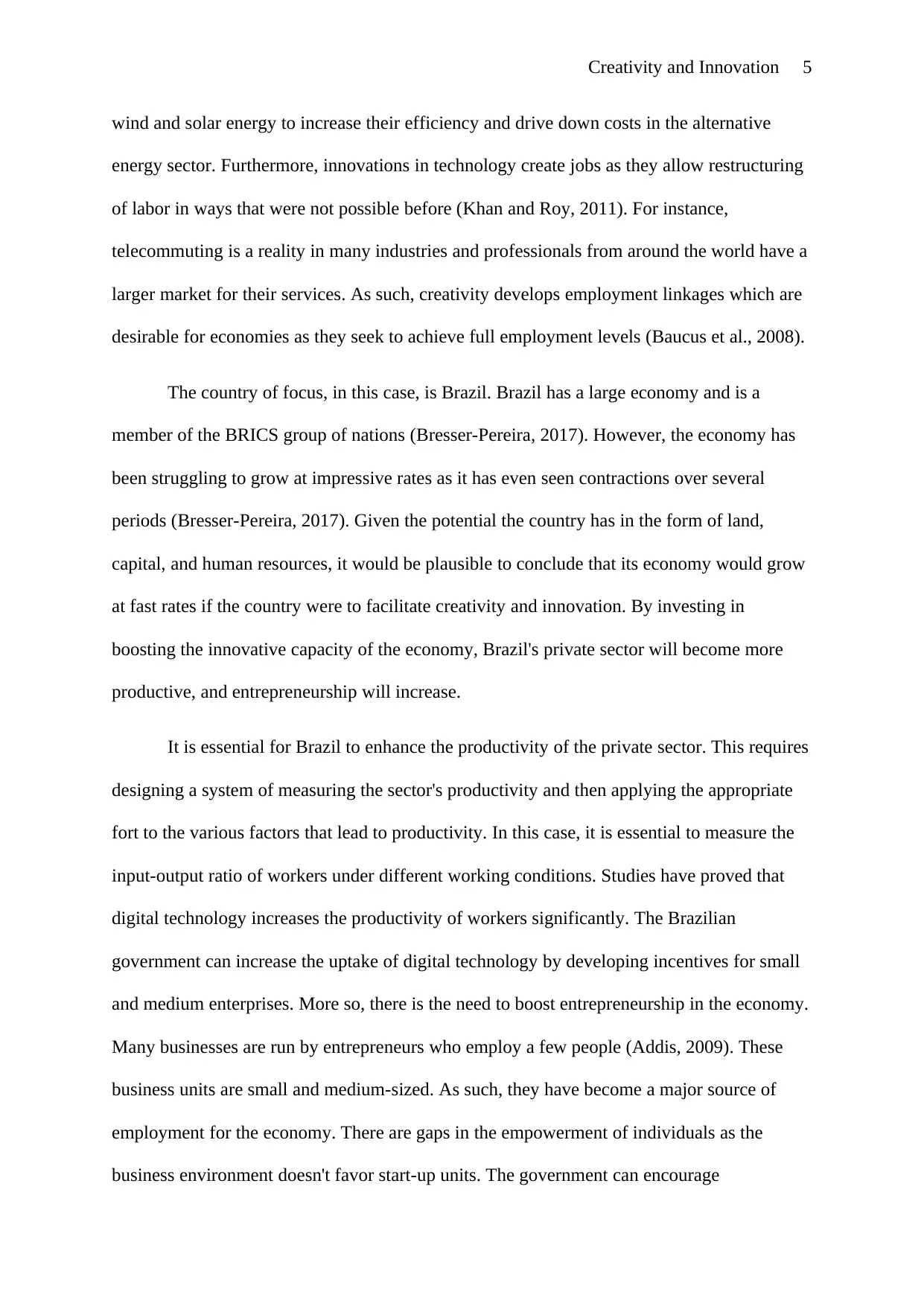
Creativity and Innovation 5
wind and solar energy to increase their efficiency and drive down costs in the alternative
energy sector. Furthermore, innovations in technology create jobs as they allow restructuring
of labor in ways that were not possible before (Khan and Roy, 2011). For instance,
telecommuting is a reality in many industries and professionals from around the world have a
larger market for their services. As such, creativity develops employment linkages which are
desirable for economies as they seek to achieve full employment levels (Baucus et al., 2008).
The country of focus, in this case, is Brazil. Brazil has a large economy and is a
member of the BRICS group of nations (Bresser-Pereira, 2017). However, the economy has
been struggling to grow at impressive rates as it has even seen contractions over several
periods (Bresser-Pereira, 2017). Given the potential the country has in the form of land,
capital, and human resources, it would be plausible to conclude that its economy would grow
at fast rates if the country were to facilitate creativity and innovation. By investing in
boosting the innovative capacity of the economy, Brazil's private sector will become more
productive, and entrepreneurship will increase.
It is essential for Brazil to enhance the productivity of the private sector. This requires
designing a system of measuring the sector's productivity and then applying the appropriate
fort to the various factors that lead to productivity. In this case, it is essential to measure the
input-output ratio of workers under different working conditions. Studies have proved that
digital technology increases the productivity of workers significantly. The Brazilian
government can increase the uptake of digital technology by developing incentives for small
and medium enterprises. More so, there is the need to boost entrepreneurship in the economy.
Many businesses are run by entrepreneurs who employ a few people (Addis, 2009). These
business units are small and medium-sized. As such, they have become a major source of
employment for the economy. There are gaps in the empowerment of individuals as the
business environment doesn't favor start-up units. The government can encourage
wind and solar energy to increase their efficiency and drive down costs in the alternative
energy sector. Furthermore, innovations in technology create jobs as they allow restructuring
of labor in ways that were not possible before (Khan and Roy, 2011). For instance,
telecommuting is a reality in many industries and professionals from around the world have a
larger market for their services. As such, creativity develops employment linkages which are
desirable for economies as they seek to achieve full employment levels (Baucus et al., 2008).
The country of focus, in this case, is Brazil. Brazil has a large economy and is a
member of the BRICS group of nations (Bresser-Pereira, 2017). However, the economy has
been struggling to grow at impressive rates as it has even seen contractions over several
periods (Bresser-Pereira, 2017). Given the potential the country has in the form of land,
capital, and human resources, it would be plausible to conclude that its economy would grow
at fast rates if the country were to facilitate creativity and innovation. By investing in
boosting the innovative capacity of the economy, Brazil's private sector will become more
productive, and entrepreneurship will increase.
It is essential for Brazil to enhance the productivity of the private sector. This requires
designing a system of measuring the sector's productivity and then applying the appropriate
fort to the various factors that lead to productivity. In this case, it is essential to measure the
input-output ratio of workers under different working conditions. Studies have proved that
digital technology increases the productivity of workers significantly. The Brazilian
government can increase the uptake of digital technology by developing incentives for small
and medium enterprises. More so, there is the need to boost entrepreneurship in the economy.
Many businesses are run by entrepreneurs who employ a few people (Addis, 2009). These
business units are small and medium-sized. As such, they have become a major source of
employment for the economy. There are gaps in the empowerment of individuals as the
business environment doesn't favor start-up units. The government can encourage
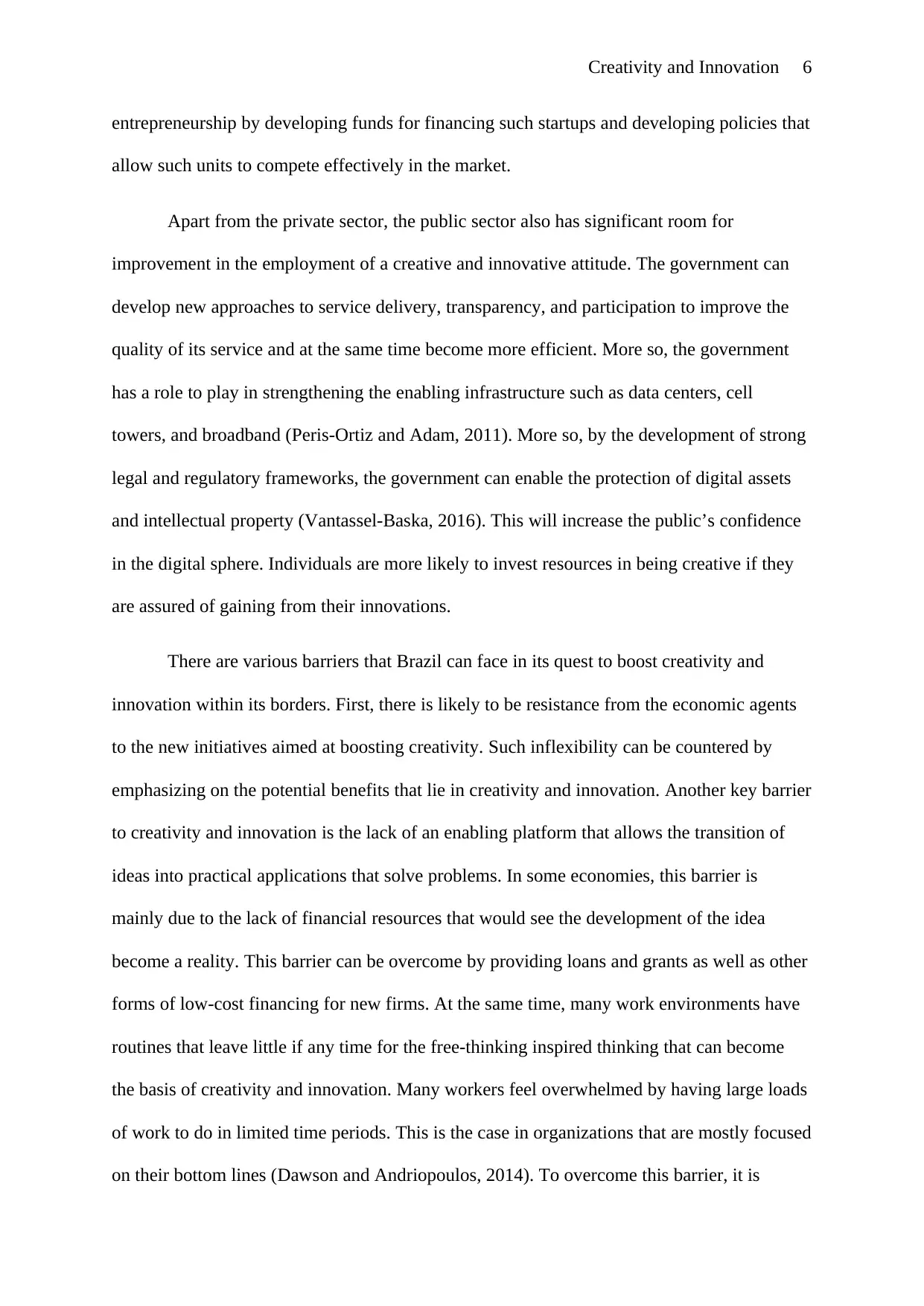
Creativity and Innovation 6
entrepreneurship by developing funds for financing such startups and developing policies that
allow such units to compete effectively in the market.
Apart from the private sector, the public sector also has significant room for
improvement in the employment of a creative and innovative attitude. The government can
develop new approaches to service delivery, transparency, and participation to improve the
quality of its service and at the same time become more efficient. More so, the government
has a role to play in strengthening the enabling infrastructure such as data centers, cell
towers, and broadband (Peris-Ortiz and Adam, 2011). More so, by the development of strong
legal and regulatory frameworks, the government can enable the protection of digital assets
and intellectual property (Vantassel-Baska, 2016). This will increase the public’s confidence
in the digital sphere. Individuals are more likely to invest resources in being creative if they
are assured of gaining from their innovations.
There are various barriers that Brazil can face in its quest to boost creativity and
innovation within its borders. First, there is likely to be resistance from the economic agents
to the new initiatives aimed at boosting creativity. Such inflexibility can be countered by
emphasizing on the potential benefits that lie in creativity and innovation. Another key barrier
to creativity and innovation is the lack of an enabling platform that allows the transition of
ideas into practical applications that solve problems. In some economies, this barrier is
mainly due to the lack of financial resources that would see the development of the idea
become a reality. This barrier can be overcome by providing loans and grants as well as other
forms of low-cost financing for new firms. At the same time, many work environments have
routines that leave little if any time for the free-thinking inspired thinking that can become
the basis of creativity and innovation. Many workers feel overwhelmed by having large loads
of work to do in limited time periods. This is the case in organizations that are mostly focused
on their bottom lines (Dawson and Andriopoulos, 2014). To overcome this barrier, it is
entrepreneurship by developing funds for financing such startups and developing policies that
allow such units to compete effectively in the market.
Apart from the private sector, the public sector also has significant room for
improvement in the employment of a creative and innovative attitude. The government can
develop new approaches to service delivery, transparency, and participation to improve the
quality of its service and at the same time become more efficient. More so, the government
has a role to play in strengthening the enabling infrastructure such as data centers, cell
towers, and broadband (Peris-Ortiz and Adam, 2011). More so, by the development of strong
legal and regulatory frameworks, the government can enable the protection of digital assets
and intellectual property (Vantassel-Baska, 2016). This will increase the public’s confidence
in the digital sphere. Individuals are more likely to invest resources in being creative if they
are assured of gaining from their innovations.
There are various barriers that Brazil can face in its quest to boost creativity and
innovation within its borders. First, there is likely to be resistance from the economic agents
to the new initiatives aimed at boosting creativity. Such inflexibility can be countered by
emphasizing on the potential benefits that lie in creativity and innovation. Another key barrier
to creativity and innovation is the lack of an enabling platform that allows the transition of
ideas into practical applications that solve problems. In some economies, this barrier is
mainly due to the lack of financial resources that would see the development of the idea
become a reality. This barrier can be overcome by providing loans and grants as well as other
forms of low-cost financing for new firms. At the same time, many work environments have
routines that leave little if any time for the free-thinking inspired thinking that can become
the basis of creativity and innovation. Many workers feel overwhelmed by having large loads
of work to do in limited time periods. This is the case in organizations that are mostly focused
on their bottom lines (Dawson and Andriopoulos, 2014). To overcome this barrier, it is
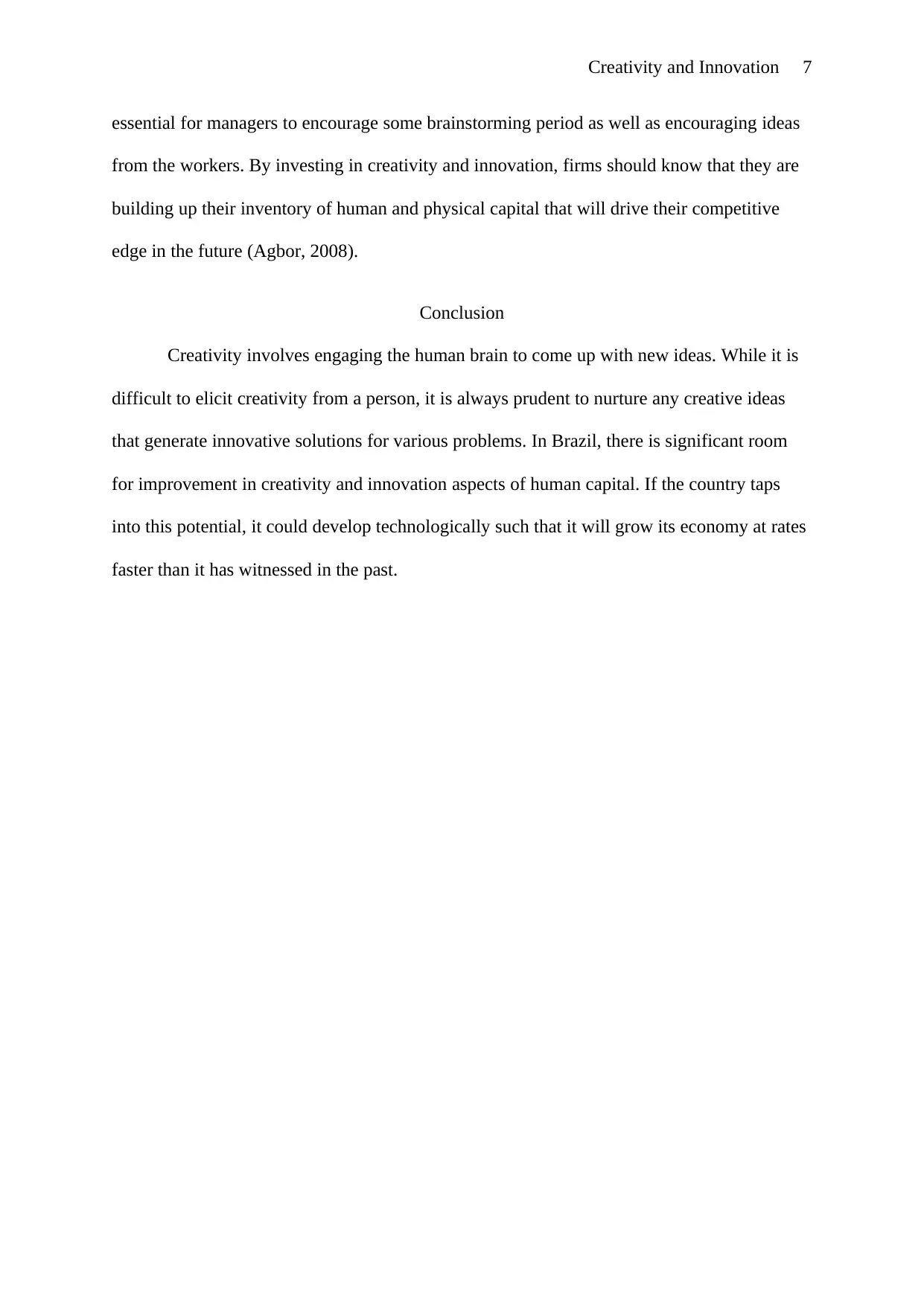
Creativity and Innovation 7
essential for managers to encourage some brainstorming period as well as encouraging ideas
from the workers. By investing in creativity and innovation, firms should know that they are
building up their inventory of human and physical capital that will drive their competitive
edge in the future (Agbor, 2008).
Conclusion
Creativity involves engaging the human brain to come up with new ideas. While it is
difficult to elicit creativity from a person, it is always prudent to nurture any creative ideas
that generate innovative solutions for various problems. In Brazil, there is significant room
for improvement in creativity and innovation aspects of human capital. If the country taps
into this potential, it could develop technologically such that it will grow its economy at rates
faster than it has witnessed in the past.
essential for managers to encourage some brainstorming period as well as encouraging ideas
from the workers. By investing in creativity and innovation, firms should know that they are
building up their inventory of human and physical capital that will drive their competitive
edge in the future (Agbor, 2008).
Conclusion
Creativity involves engaging the human brain to come up with new ideas. While it is
difficult to elicit creativity from a person, it is always prudent to nurture any creative ideas
that generate innovative solutions for various problems. In Brazil, there is significant room
for improvement in creativity and innovation aspects of human capital. If the country taps
into this potential, it could develop technologically such that it will grow its economy at rates
faster than it has witnessed in the past.
Paraphrase This Document
Need a fresh take? Get an instant paraphrase of this document with our AI Paraphraser
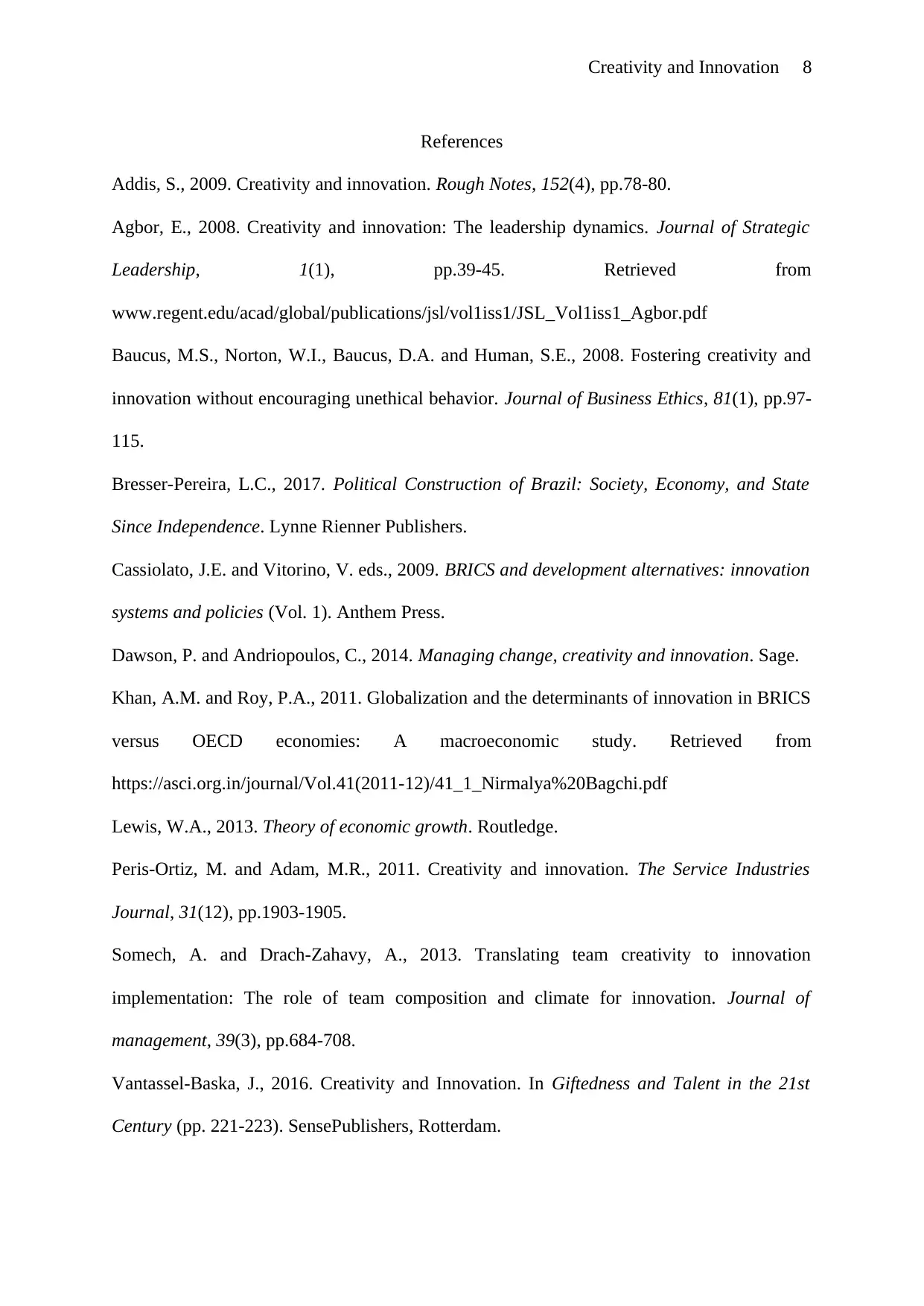
Creativity and Innovation 8
References
Addis, S., 2009. Creativity and innovation. Rough Notes, 152(4), pp.78-80.
Agbor, E., 2008. Creativity and innovation: The leadership dynamics. Journal of Strategic
Leadership, 1(1), pp.39-45. Retrieved from
www.regent.edu/acad/global/publications/jsl/vol1iss1/JSL_Vol1iss1_Agbor.pdf
Baucus, M.S., Norton, W.I., Baucus, D.A. and Human, S.E., 2008. Fostering creativity and
innovation without encouraging unethical behavior. Journal of Business Ethics, 81(1), pp.97-
115.
Bresser-Pereira, L.C., 2017. Political Construction of Brazil: Society, Economy, and State
Since Independence. Lynne Rienner Publishers.
Cassiolato, J.E. and Vitorino, V. eds., 2009. BRICS and development alternatives: innovation
systems and policies (Vol. 1). Anthem Press.
Dawson, P. and Andriopoulos, C., 2014. Managing change, creativity and innovation. Sage.
Khan, A.M. and Roy, P.A., 2011. Globalization and the determinants of innovation in BRICS
versus OECD economies: A macroeconomic study. Retrieved from
https://asci.org.in/journal/Vol.41(2011-12)/41_1_Nirmalya%20Bagchi.pdf
Lewis, W.A., 2013. Theory of economic growth. Routledge.
Peris-Ortiz, M. and Adam, M.R., 2011. Creativity and innovation. The Service Industries
Journal, 31(12), pp.1903-1905.
Somech, A. and Drach-Zahavy, A., 2013. Translating team creativity to innovation
implementation: The role of team composition and climate for innovation. Journal of
management, 39(3), pp.684-708.
Vantassel-Baska, J., 2016. Creativity and Innovation. In Giftedness and Talent in the 21st
Century (pp. 221-223). SensePublishers, Rotterdam.
References
Addis, S., 2009. Creativity and innovation. Rough Notes, 152(4), pp.78-80.
Agbor, E., 2008. Creativity and innovation: The leadership dynamics. Journal of Strategic
Leadership, 1(1), pp.39-45. Retrieved from
www.regent.edu/acad/global/publications/jsl/vol1iss1/JSL_Vol1iss1_Agbor.pdf
Baucus, M.S., Norton, W.I., Baucus, D.A. and Human, S.E., 2008. Fostering creativity and
innovation without encouraging unethical behavior. Journal of Business Ethics, 81(1), pp.97-
115.
Bresser-Pereira, L.C., 2017. Political Construction of Brazil: Society, Economy, and State
Since Independence. Lynne Rienner Publishers.
Cassiolato, J.E. and Vitorino, V. eds., 2009. BRICS and development alternatives: innovation
systems and policies (Vol. 1). Anthem Press.
Dawson, P. and Andriopoulos, C., 2014. Managing change, creativity and innovation. Sage.
Khan, A.M. and Roy, P.A., 2011. Globalization and the determinants of innovation in BRICS
versus OECD economies: A macroeconomic study. Retrieved from
https://asci.org.in/journal/Vol.41(2011-12)/41_1_Nirmalya%20Bagchi.pdf
Lewis, W.A., 2013. Theory of economic growth. Routledge.
Peris-Ortiz, M. and Adam, M.R., 2011. Creativity and innovation. The Service Industries
Journal, 31(12), pp.1903-1905.
Somech, A. and Drach-Zahavy, A., 2013. Translating team creativity to innovation
implementation: The role of team composition and climate for innovation. Journal of
management, 39(3), pp.684-708.
Vantassel-Baska, J., 2016. Creativity and Innovation. In Giftedness and Talent in the 21st
Century (pp. 221-223). SensePublishers, Rotterdam.
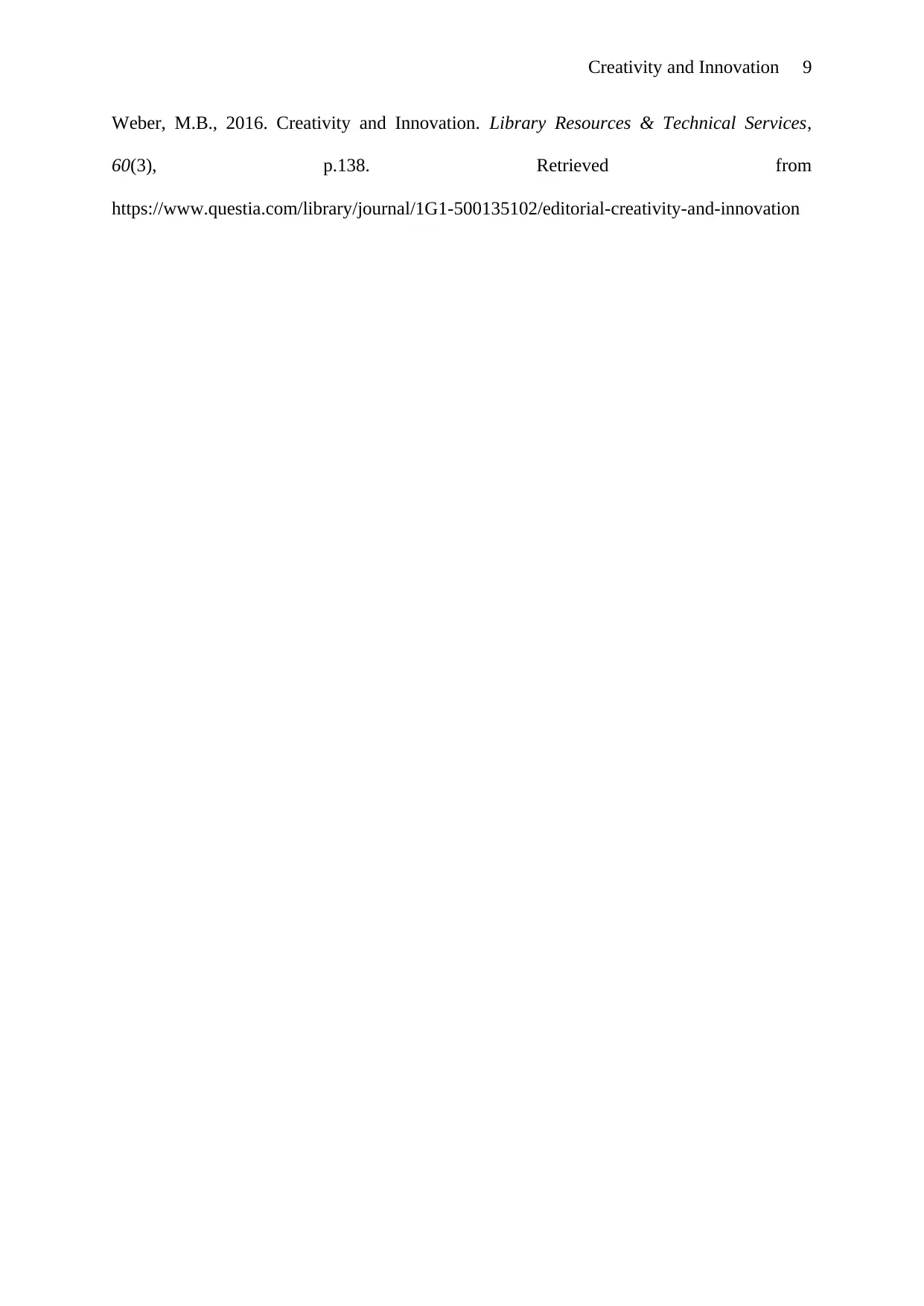
Creativity and Innovation 9
Weber, M.B., 2016. Creativity and Innovation. Library Resources & Technical Services,
60(3), p.138. Retrieved from
https://www.questia.com/library/journal/1G1-500135102/editorial-creativity-and-innovation
Weber, M.B., 2016. Creativity and Innovation. Library Resources & Technical Services,
60(3), p.138. Retrieved from
https://www.questia.com/library/journal/1G1-500135102/editorial-creativity-and-innovation
1 out of 9
Related Documents
Your All-in-One AI-Powered Toolkit for Academic Success.
+13062052269
info@desklib.com
Available 24*7 on WhatsApp / Email
![[object Object]](/_next/static/media/star-bottom.7253800d.svg)
Unlock your academic potential
© 2024 | Zucol Services PVT LTD | All rights reserved.





